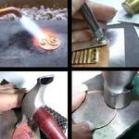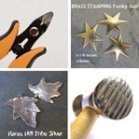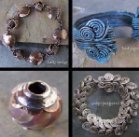▪ Jewelry Metals ▪
Here are the most common metals used in creating artisan jewelry. There are also jewelers who use iron and steel products and, of course, platinum and karat gold used in making fine jewelry.
Pure copper wire
Great for practicing with as it is relatively inexpensive. However, you can create beautiful jewelry with this wonderful warm metal. Available in gauges from 30 gauge to 6 gauge.
Fine silver
This is a pure silver product. It resists tarnishing and may be melted without any porosity (pitting). Great for incorporating into lampwork, and making your own ball tip headpins. It is softer than Sterling silver and maintains its pliability longer, making it a good choice for very fine wire wrap projects.
Sterling silver
.925 = 92.5% Silver / 7.5% copper. Available in a wide array of shapes and hardnesses.
Coin silver
90% silver / 10% copper
Nickel silver
0% silver / 65% copper / 17% zinc / 18% nickel
Artistic Wire
Permanently colored copper wire.
Gold-filled Wire
A wire made by fusing a layer of karat gold to a suitable supporting metal or alloy. Using carefully controlled heat, pressure and time, the bond produced is permanent. The metal is then rolled and compressed into a sheet. Repeated rolling helps to increase the density of the gold so that it becomes harder and more durable.
To make jewelry designing easier, I keep a supply of the wire gauges I use the most at my work bench. The gauges I use most often are: 12, 14, 16, 18, 20, 22, and 24 gauges. You may combine metals like Sterling silver and copper and even brass and gold-filled to add interest to your designs.
I prefer using dead soft wire for most of the jewelry I make as it's easier to manipulate and I can harden it myself either by working with it (work-harden) or by heating. Some designers prefer half hard wire, some prefer dead soft. I encourage you to try the different hardnesses of wire to see which suits your needs the best.
Other wire-related topics:
Wire Hardness
Jewelry wire gauge
















